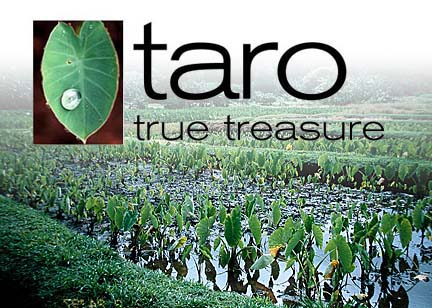
The Hawaiian staple and the way
it's grown are welcomed on
the Ark of Taste, a lifeboat
to keep culinary traditions alive
When Noah got all those animals on the ark -- that worked out pretty well. The world certainly has plenty of critters to show for the effort.
The symbolism bodes well for a modern effort at salvation, this time involving native foods.
This is the thinking behind the Ark of Taste, a sort of lifeboat for foods and culinary traditions that are in danger of dying out.
One of the latest foods invited onto the ark: Hawaiian poi taro. Not just the starchy root, but the traditional way of growing it.
"There was not much of a debate," said Robert LaValva, the modern-day Noah who administers the ark. "It's almost crystal clear that this belonged on the ark."
The ark is the creation of the Slow Food Movement, an international group opposed to the principals of a fast-food society: You know, eat quick; the cheaper and more homogeneous the meal, the better.
The 65,000 members take pleasure in fine foods, but theirs is not a gourmet organization. It's an activist and educational one, devoted to preserving regional culinary traditions and protecting foods of purity and craftsmanship. One of its tools is the Ark of Taste.
Taro's admission to the Slow Food U.S.A. branch of the ark came in September. In all, 75 foods were "boarded onto the ark" at a meeting of the ark committee in Madison, Wisc., LaValva said.
Taro's companions include wild plums, heirloom fruits, some cattle, a hog, "even some unusual things like a birch syrup made in Alaska and a traditional American root beer," he said.
Suitability for the ark is judged on four criteria: The food must be of high quality and part of a cultural tradition with deep roots in this country. It must be endangered, but the chance must remain that it can be revived, sustainably. This means the food can be grown in harmony with the environment (no overdependence on chemical pesticides, for example).
"Taro fits in well with the concept of the ark, which is not to let go of these customs and traditions," LaValva said.
Taro was nominated by Nan Piianaia, head of the Slow Food Hawaii "convivium," the designation for a local chapter.
Piianaia specified the varieties called Maui lehua, lehua maoli and moi -- all grown in Hawaii for poi and luau leaves. Her nomination recounted taro's journey to Hawaii with Polynesian settlers and the traditional method of growing in water-filled lo'i.
"Poi taro, known as kalo to the ancient Hawaiians, is cultivated throughout the South Pacific," she wrote. "But only in Hawaii did it become the most important component of a staple diet and an integral part of the culture."
By legend, taro is considered the elder brother of man. The word ohana -- family -- is also the word for the offshoots of the taro corm, "the source of life," Piianaia said.

Nan Piianaia, shown here at the first meeting of the Slow Food Hawai'i convivium, nominated taro for placement on the Ark of Taste.
Placement on the ark is largely symbolic, and Piianaia said she's not sure how much good the gesture will actually do. "I suppose the taro farmers will say, 'so what?' and they have a point."
With a background in culinary and historic research, she hopes to interview poi farmers in the Big Island's Waipio Valley, to document their struggles and develop ways that the Slow Food organization can help keep the industry alive.
"It seems as though everywhere in Hawaii agriculture is struggling -- competition from outside, terrible weather and young persons no longer willing to endure the hardship and risk. I wish it were a different story."
The effect of Noah's original ark was by no means instant. Before the 40 days and 40 nights of flood, Noah spent 110 years building the ark (there were lots of specifications). And afterward, the animals had to do their part, procreating and such.
So it will be with the Ark of Taste.
LaValva said 250 items have entered the U.S. ark since it was founded in 2001. "There's plenty of room, and it's a huge country, too."
Just making the list can help, especially when Slow Food takes the next step of advocacy. Take the case of heritage turkey, a naturally grown American turkey -- not the breast-heavy commercial variety.
LaValva said Slow Food encouraged farmers to raise the turkeys and its members to buy them, attracting a great deal of press coverage. "Results have been phenomenal. I think in the year 2000 there were fewer than 500 of these birds being raised for food and now we think the number has gone up to 20,000 a year -- that we know about."
When taro was evaluated by the ark committee, the members all had a taste of poi. For many it was their first, and you can imagine the reaction. "It wasn't really to everybody's liking," LaValva admits.
But a universal scale of taste preference isn't part of the ark philosophy.
"Taro is without question part of a very old tradition," he said. "That tradition is very important, not just to the culture, but also to the health of the native people. That is in the spirit of the ark -- that it is not very common anymore and in danger of being forgotten."
[News] [Business] [Features] [Sports] [Editorial] [Do It Electric!]
[Classified Ads] [Search] [Subscribe] [Info] [Letter to Editor]
[Feedback]
